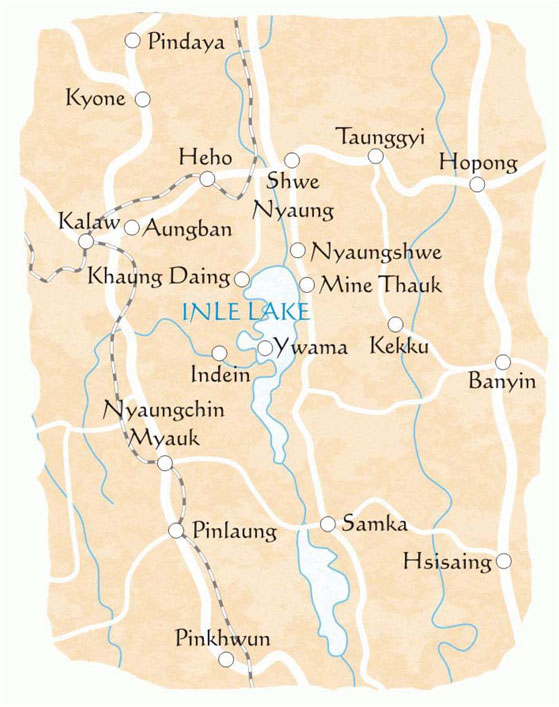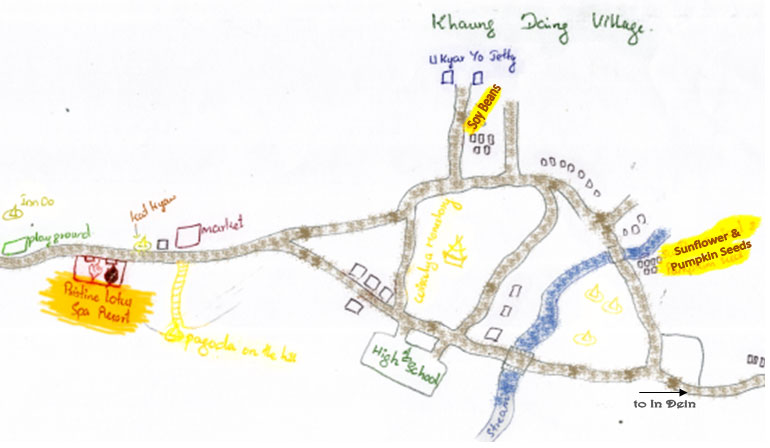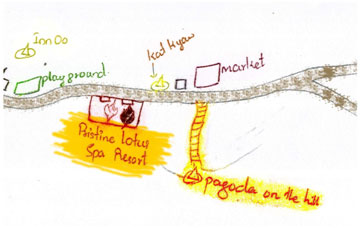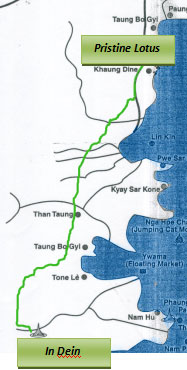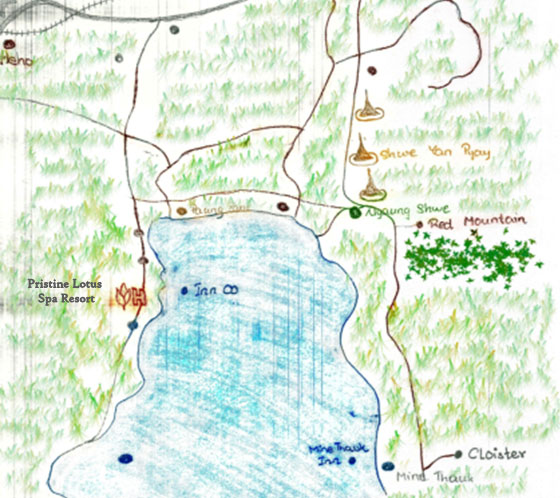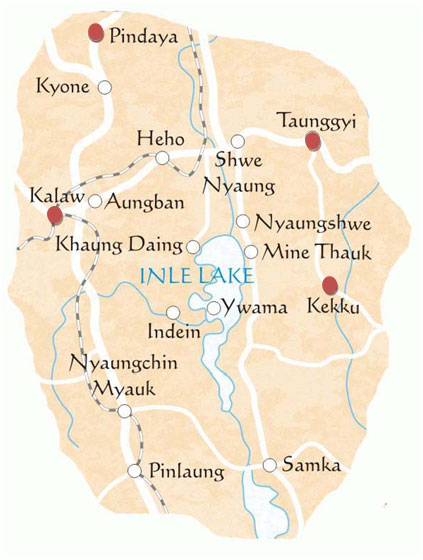Around Inle Lake
There are many ways to discover Inle Lake. The most famous is by boat, of course,but there are also other ways to get around. We will give you some suggestions, but at the end it is your decision how you‘d like to see the Lake. The most important suggestion – open your eyes.
Floating Gardens : Inle Lake has a unique style of aquaculture. The Inthas live on the lake and also live off of it, thanks to their floating gardens. Intha farmers grow flowers and vegetables such as tomatoes and squash on long strips of floating land. The land is formed through the collection of tangled water hyacinth, weeds and reeds that accumulate on the rim of the lake; the Inthas tie the land down to the bottom of the lake with long bamboo poles.
Ywama:The largest village on the Inlay Lake; its streets are a web of canals. There are some beautiful teak houses built on large wooden piles driven into the lake bed. The main activity and attraction is at the floating market in the largest canal. The magnificent floating market is renowned. You can visit the goldsmith workshops, observe the sculpture and umbrella industries.
Phaung Daw Oo Pagoda:One of the famous principal shrines in Myanmar, this pagoda houses five small Buddha images, which are much revered by the lake-dwellers. Once a year, in late September – early October, there is a pagoda festival during which, four of the five Buddha images tour around the lake in a colorful barge.
In Dein:One of the small villages of Inle Lake located on the western bank of the lake. The ruin pagodas, hide in the bushes will give you an impression of you were in the 12th – 13th Centuries ago. This mysterious place is at the end of the marvellous Indein creek, which connected with Inle Lake just after the Phaung Daw Oo Pagoda.
Nga Phe Kyaung Monastery:The Nga Phe Kyaung is the biggest and oldest monastery in Inle Lake. It is a beautiful wooden structure that was built on stilts over the lake at the end of the 1850s. The monastery is home to a collection of ancient Bagan, Shan, Tibet and Ava-style Buddha images.
In Paw Khone: The fantastic and fabulous hand-weaving silk patterns are weaved in Inn Paw Khon village. The processes (such as tied and dyed) in detail procedures, the technique and creation of the fascinating design of the silk products can be seen and bought there.
Khaung Daing is the native village next to Pristine Lotus Spa Resort. It is known for its production of tofu, soybean cakes and noodles. There are some interesting Shan style temples just outside the village.
The ‘Pagoda on the hill’ is in walking distance of Pristine Lotus (15 min). Actually there are two pagodas up the hill from where you have a beautiful view on the lake. Just go direction Khaung Daing up to the monastery/ market and take the path on the left side. Please wear proper shoes as the path is of rocks.
In Dein is one of the small villages of Inle Lake located on the western bank of the lake. A Buddha image has enshrined at a whitewashed stupa. which is on the summit of a hill. Below the stupa around the hill are cluster of hundreds of ancient stupas most are ruins overgrown with bushes. The pagoda hill is quiet and calm. One could feel the pleasant cool breeze with the sweet rings of the bells hanging at the umbrella of the stupa. Mesmerizing view from pagoda hill release the fatigue and refresh everybody who ascend to the peak.
Take a bike ride to In Dein and discover the landside of Inle area, passing by a lot of cane sugar and some small villages. It will take around 1 ½ hour to go to In Dein
Nyaung Shwe is the tourist hub for visiting Inle Lake. It consists of one main thoroughfare with numerous side streets and a few parallel roads. The main street has numerous shops, several restaurants, a few stupas, travel agencies and a market (located behind the storefronts). Near the end of this road, a bridge crosses the river channel near an impressive mirror-tiled stupa.
The town serves as a marina for the numerous long boats carrying tourists into the lake. The lake itself is located a few kilometers south through a river channel.
Take a bike ride to Nyaung Shwe (30 min) or go by boat (20 min) and discover this charming place on your own.
The Red Mountain Wine Estate, located on the east side of the famous Inle Lake, is one of the first locale wine producers in Myanmar. Since the beginning, the wines are produced with locally grown grapes. All of the 400,000 plants have been imported from France and Spain, and the variety chosen after experimentations.
It’s a combination of different factors, the cool climate, the soils, the long experience of the French winemaker. The wines are made in the tradition of western wines with all new technologies and modern equipments.”
You can go by bike or boat to Nyaung Shwe and go on by car (10 min) or bicycle (30 min) up to the mountainside.
While tasting and discovering the different varieties of the Red Mountain Wines, you will enjoy a stunning view on the lake.
Pindaya is a town in the Shan State of Burma. It is located in the west of the state in Pindaya Township in Taunggyi District. Mainly famous for its limestone caves called Pindaya Caves where thousands of Buddha images have been consecrated for worship over the centuries, it is also one of the towns that host an itinerant market every fifth day.
Taunggyi is the capital of Shan State, Myanmar. Taunggyi has an estimated population of 205,000 As of 2010,[1] making it the fifth largest city in Myanmar. The name Taunggyi means “huge mountain” in the Burmese language, and is named after the ridge on the east of the city, part of the Shan Hills system, whose prominent high point is called Taung-chun or “The Spur.” The Taunggyi area is a popular tourist destination. The city itself has an interesting five-day market, where farmers from around the area would come to the Taunggyi on market day and sell fresh produce in the open market.
One of the Asia’s largest and most spectacular ancient monuments is a wonderful Pagoda named Kekku. It contains over 2.000 stupas with origins dating back many centuries. It exists not only as an outstanding example of tradition art and architecture but also as a testament to the religious devotion of one of Myanmar’s many ethnic minorities. the Pa-Oh. For many centuries, the Pa-Oh has lived in peace, cultivating their land and devoting much of their energy and limited wealth to creating monasteries and pagodas.Kakku is about 33 miles from Taunggyi. It will take about 3 hours drive by car.
Kalaw stands high on the western edge of the Shan Plateau. This was a popular hill station in the British days and it is still a peaceful and quiet place. At an altitude of 1320 m it is also pleasantly cool and a good place for hiking amid gnarled pines, bamboo groves and rugged mountain scene.


